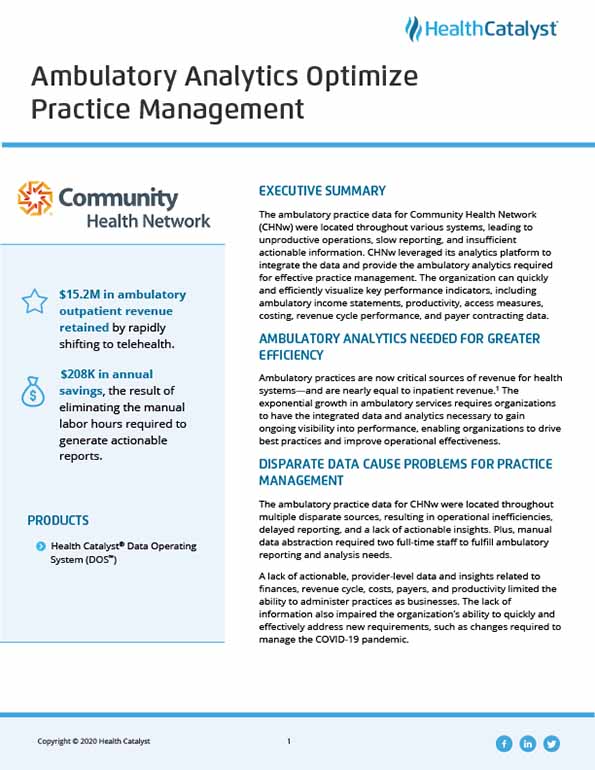The ambulatory practice data for Community Health Network (CHNw) were located throughout various systems, leading to unproductive operations, slow reporting, and insufficient actionable information. CHNw leveraged its analytics platform to integrate the data and provide the ambulatory analytics required for effective practice management. The organization can quickly and efficiently visualize key performance indicators, including ambulatory income statements, productivity, access measures, costing, revenue cycle performance, and payer contracting data.
Ambulatory practices are now critical sources of revenue for health systems—and are nearly equal to inpatient revenue.1 The exponential growth in ambulatory services requires organizations to have the integrated data and analytics necessary to gain ongoing visibility into performance, enabling organizations to drive best practices and improve operational effectiveness.
The ambulatory practice data for CHNw were located throughout multiple disparate sources, resulting in operational inefficiencies, delayed reporting, and a lack of actionable insights. Plus, manual data abstraction required two full-time staff to fulfill ambulatory reporting and analysis needs.
A lack of actionable, provider-level data and insights related to finances, revenue cycle, costs, payers, and productivity limited the ability to administer practices as businesses. The lack of information also impaired the organization’s ability to quickly and effectively address new requirements, such as changes required to manage the COVID-19 pandemic.
The organization needed an ambulatory analytics solution that could integrate data from multiple sources and provide actionable insights to gain efficiencies and optimize practice management. CHNw desired a solution that was flexible and could be scaled effectively to meet changing practice requirements and support future growth.
CHNw leverages the Health Catalyst® Data Operating System (DOS™) platform and a robust suite of analytics applications to integrate data from multiple disparate source systems. Using DOS, CHNw has the robust ambulatory analytics required for effective practice management and future growth. The organization can quickly and efficiently visualize key performance indicators, including ambulatory income statements, productivity, access measures, costing, revenue cycle performance, and payer contracting data.
DOS enables extensive collaboration with providers across the organization to generate the standard work needed to manage ambulatory practices successfully. Providers can analyze their work relative value units (wRVUs) to understand the impact of changing workflows and volumes on revenue, and can execute and analyze various productivity scenarios, such as the impact of working an additional day per month on wRVUs, access, patient experience, and revenue.
Practices can generate a schedule “heat map” to reveal high-demand times, enabling the clinic to offer access-expanding alternatives. Practices can visualize and evaluate provider-specific panel counts, create and analyze weighted panels, study panel and network growth dynamics, and examine payer mix and attribution rates by utilizing powerful patient panel management analytics.
CHNw leveraged its ambulatory analytics to support its pivot from mostly in-person visits to primarily virtual visits quickly and efficiently. This rapid and effective change ensured patients were able to receive necessary medical care amid the COVID-19 pandemic. The data platform enables access to timely data on testing demographics, positive test result counts, the number of related inpatient visits, and performance for other key metrics.
CHNw can analyze virtual-visit utilization by provider and by the telemedicine method used. It also can visualize the impact of different virtual-visit scenarios on access, productivity, and revenue. CHNw uses the scenario modeling to identify the optimal mix of virtual-visit type while also closely monitoring health equity and patient outcomes.
CHNw’s robust ambulatory analytics has improved the organizational ability to optimize practice management, enabling the organization to continuously improve the effectiveness of its operations. Results include:
"We leveraged the power of the Health Catalyst Data Operating System to obtain a single source of truth and generate valuable insights down to the individual provider, leading to increased efficiencies and productivity across all of our ambulatory practices."
- Patrick McGill, MD, FAAFP, Executive Vice President, Chief Analytics Officer, Community Health Network
CHNw plans to continue to expand the utilization of its powerful data platform to support the organization’s growing ambulatory practice base.


